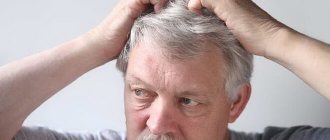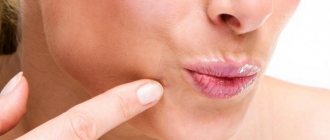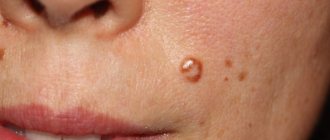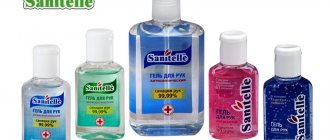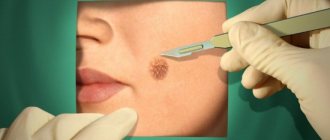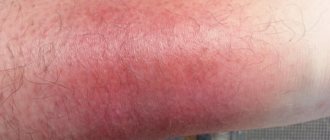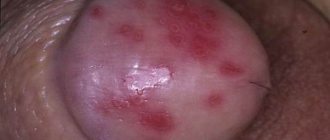Warts are a fairly common problem for many people. They arise due to the entry of the human papillomavirus into the body and are small-sized neoplasms with a keratinized crust or completely soft growths.
Most often, warts are not painful, but there are reasons why warts can cause discomfort and pain.
Pain when a wart is damaged
If the wart is inflamed and hurts, then first of all you should think about the fact that it has been damaged.
This happens most often if the formation is localized in some unfortunate place.
For example, this could be the armpit, the area under the breasts of the fair sex, etc.
The growth may be located in a seemingly problem-free place.
But at the same time, when wearing clothes, it can be influenced by friction that occurs upon contact with fabrics.
Damage to the formation is the most common cause of unpleasant symptoms.
Traumatization can be either quite pronounced, up to the appearance of blood, or weak, but systematic.
The second option is most often found during friction.
Doctors draw the attention of patients to the fact that problem areas should remove growths as early as possible.
This will help avoid their irritation and subsequent negative changes.
Also, all pathogenic growths, which are often rubbed with clothing, must be removed as early as possible.
Provided that a person does not have the opportunity to change style.
An option may be to change synthetic clothing to natural ones.
There is no guarantee that this approach will be an effective way to solve the problem.
Treatment with medications
For pain and inflammation, various local remedies are used that have anti-inflammatory and bactericidal effects. The most effective ointments are Betadine, Ichthyol, Vishnevsky. They must be applied to the damaged surface of the papilloma several times a day, covering the area with a bandage.
It is also recommended to use antiviral drugs that affect the cause of inflammation (Oxolinic ointment, Viferon, Acyclovir, Panavir).
There are also medicinal methods of getting rid of warts using drugs with salicylic acid, Celandine balm, etc. They should be used only after consultation with a doctor and in the absence of contraindications.
Malignancy of a wart
If the wart turns black and hurts, then first of all, many patients think that it has been affected by the process of malignancy.
Such concern is not unfounded.
Moreover, malignancy is the most serious reason why a patient may complain of pain in a tumor.
It is important to remember that skin cancer or, as doctors also call it, melanoma, is prone to rapid development.
In addition to its rapid development, it is also very difficult to treat.
Because of this, it is recommended to begin treatment as soon as the first signs are detected.
Doctors note that malignancy of warts rarely occurs just like that.
Often this process is facilitated by prolonged local inflammation.
Also, rubbing a wart against clothing or other parts of the body can cause a harmless growth to turn into a malignant tumor.
Ideally, patients should direct their efforts to prevent degeneration.
If the moment has already been missed, you should use the help of a dermatovenerologist.
For a complete diagnosis and selection of optimal treatment options that will help in a particular case.
Spica: wart on the leg
If a person has a wart on his leg, it is worth thinking about such a phenomenon as a thorn.
Moreover, as noted by patients suffering from such a pathology, the pain is usually quite acute.
First, the patient loses the ability to step on his bare foot, and over time, problems with wearing shoes appear.
The spine is characterized by a very specific growth pattern.
We must not forget that it is located on the foot, and the foot, in turn, takes on the weight of the entire body during movement.
As a result, the wart is not able to grow outward, as it usually does on the fingers, armpits or other places.
It begins to slowly grow deeper, affecting the deep layers of the skin.
In this case, a small depression is formed on the surface, resembling a crater.
Interestingly, spines can grow not only on the soles, but also on other parts of the body.
It’s just that most often, due to high pressure and the impossibility of external growth, they affect the feet.
Spine, like other types of warts, can be treated, although it can be quite difficult.
In most cases, it is not possible to manage only conservative methods in the fight against this disease.
Prevention measures
No one is immune from this pathology, and most likely everyone has the virus. Only when the body’s defenses are reduced do warts begin to actively grow and stand out against the background of the epidermis. The first way to prevent the development of such a problem is immunization. To do this, you need to take vitamin complexes, lead a healthy lifestyle, and maintain hygiene. Under no circumstances should you use the personal equipment of a sick person; you should avoid touching him.
This video will tell you what to do if a mole becomes inflamed:
Symptoms that may accompany wart pain
Painful growth is generally not the only symptom of negative changes that a patient may complain about at an appointment with a dermatovenerologist.
Often an additional group of complaints is presented regarding the affected area of the skin.
These include:
- Inflammatory symptoms
Symptoms of inflammation most often include pain.
However, they are not limited to pain.
The patient may complain that the tumor has become red and very sensitive to touch.
In some cases, it may be noted that it has increased in size or the tissue around it has become swollen.
- Skin symptoms
Patients often feel that the wart is itchy and a pronounced burning sensation appears in the area.
These symptoms contribute to increased inflammation.
Especially if a person cannot restrain himself and combs the problem area.
- Blood discharge
Often, if the scratching is very strong, blood is released from the formation in small quantities.
If the growth is very severely injured, the bleeding may be noticeable, and sometimes medical assistance is required to stop it.
Methods for relieving inflammation
If the oncological nature of the neoplasm is not confirmed, the pain and inflammation in the affected area must be relieved. In case of mechanical damage, the following is required:
- wash out the damage;
- carry out disinfection with an antiseptic: 3% hydrogen peroxide, alcohol, Chlorhexidine, solutions of Furacilin, Miramistin, Betadine;
- cauterize the wound with iodine, brilliant green or potassium permanganate to stop the bleeding;
- apply a sterile bandage on top (bandage and cotton wool or a breathable fabric-based patch);
- in case of suppuration, it is necessary to destroy the bacterial infection introduced into the wound: lubricate it with ointment or gel based on antibiotics (Levomycytin, Levomekol, Baneocin), apply a cotton swab, secure it with a bandage;
- monitor the condition of the injury, change the bandage twice a day until complete recovery;
- prevent re-damage to the wart.
The pain in the growth area can be relieved with a local anesthetic (Lidocaine, Nise-gel).
Pain after fighting warts
If a person has pain after removing a wart, this is not a reason to be surprised or worried.
The fact is that mild pain is a normal reaction of the body to contact with caustic substances that are used to get rid of growth.
On average, as doctors note, the pain goes away after a few days.
Warts hurt after nitrogen, laser, or using celandine.
Often, unpleasant sensations are a consequence of inaccurate application of the medicinal substance.
Because of this, the skin unaffected by the virus was damaged.
However, even if the substance is applied perfectly, or the laser beam is aimed perfectly, pain may be present.
We must not forget that after the growth falls off, a small skin defect will form in its place.
It is he, and not the pathogenic neoplasm itself, that will cause pain to the patient.
However, as doctors note, such defects heal quite quickly without any traces.
Especially if the growth was initially small in size.
As soon as the skin heals, the pain will disappear.
The main thing is to ensure proper skin care during this period.
Folk remedies for papillomas
You can remove an infectious neoplasm at home using folk remedies. You can do this using:
- Laundry soap.
- Celandine.
- Garlic juice.
- Raw potatoes.
- Onions.
- Calendula.
- Sea buckthorn oils.
- Tea tree essential oil.
- Apple cider vinegar.
Some remedies are used in their pure form, while others are used to prepare medicinal decoctions and infusions. Traditional therapy methods can be used only when there is certainty that the formation is of benign origin.
Removing warts with potassium permanganate: how to prepare and use the solution
Previous post
How to get rid of flat warts on the face: effective methods
Next entry
A wart hurts, what should I do?
Patients often ask doctors about what to do if a wart hurts.
Any competent dermatovenerologist will tell you that if pain occurs, you should immediately consult a doctor.
At the appointment, the doctor will be able to decide what the cause of the pain is, and also choose the best option to eliminate it.
Moreover, in some cases the growth will have to be removed, in some cases the clothing habits will have to be changed.
And in some cases you simply use light ointments to care for the defect (for example, Fenistil to eliminate itching, etc.).
The decision on tactics is made in each individual case individually.
If a wart hurts after celandine or other removal products, it is important to properly care for the injured skin.
First of all, the patient is recommended to treat the affected area with iodine or another antiseptic substance.
You can also apply a bandage or adhesive tape to the wound.
This will prevent pathogenic microorganisms from entering it.
If the pain cannot be relieved for a long time, it is worth visiting a doctor for consultation and deciding what to do next.
Diagnostics
Since warts may resemble some other skin tumors, which sometimes have an unfavorable course, if a wart appears, it is necessary to consult a dermatologist. The diagnosis of warts is based on the clinical picture.
Warts can hide under the guise of other skin diseases, so they are not always distinguishable with the naked eye. For example, plantar warts need to be distinguished from calluses. Don't self-diagnose! Contact specialists.
Typing the genotype of the HPV virus that causes warts is done using PCR diagnostics, since polymerase chain reaction (PCR) allows you to detect the DNA of the virus with high sensitivity and determine its type.
What complications can you encounter if you don’t visit a doctor if you have wart pain?
If the wart hurts and grows, or other negative changes occur with it, you should be prepared to encounter dangerous complications.
First of all, as doctors say, the threat is infection.
Often it penetrates the wart if it has been injured to the point of bleeding or the patient has scratched it.
Pathogenic microorganisms begin to actively multiply in damaged tissues.
Only increasing pain, itching and burning.
In most cases, even if infection cannot be prevented, it resolves quite easily.
However, with a strong decrease in the body’s immunity, a whole range of unpleasant consequences is possible.
Up to the point of ending up in intensive care.
Another dangerous complication is malignancy or, as they also say, malignant degeneration of the tumor.
As soon as the growth turns into a full-fledged tumor, it begins to gradually destroy the surrounding tissue and metastasize.
As a result, health damage can be irreparable.
And changes in the body, if no measures are taken in a timely manner, are lethal.
Complications of the human papillomavirus are often much more dangerous than the virus itself.
Is it necessary to go to the doctor?
Is it necessary to visit a dermatologist if a wart hurts or bleeds?
Even if it was a mechanical injury and after all the measures taken the wound began to heal, it is still worth going to see a specialist. In damaged growths, various processes may occur that are invisible to the eye, which will only appear after some time. It is better to immediately protect yourself by showing the wart to a doctor and, if necessary, getting tested.
It is better to entrust the removal of warts to a specialist.
When warts hurt in several places at once, the cause may be hidden in diseases of the internal organs. Timely diagnosis will allow the disease to be detected and treated.
